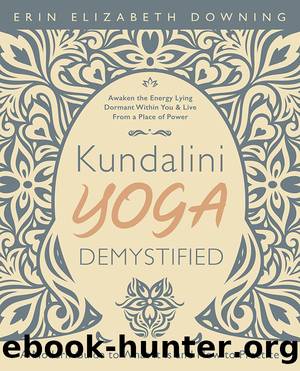Kundalini Yoga Demystified by Erin Elizabeth Downing

Author:Erin Elizabeth Downing
Language: eng
Format: epub
Tags: CVR01212021;yoga;kundalini;kundalini yoga;kundalini for beginners;kundalini yoga for beginners;kundalini yoga demystified;practicing kundalini;how to practice kundalini yoga;how to practice kundalini;erin elizabeth downing;erin downing
Publisher: Llewellyn Worldwide, LTD.
Published: 2021-09-16T18:36:34+00:00
The Power of the Pause
Kundalini is arguably the most meditative and spiritual of the yogic lineages. Kundalini focuses on the subtle nuances of the body and mind to achieve balanceâbalance within yourself, your environment, and your ecosystems. Kundalini was developed from the belief that when we push past our physical, mental, and emotional limitations and overexert ourselves, we lose the ability to maintain awareness. Its focus is on helping an individual find the right balance between pushing too hard and not pushing enough.
You might find yourself unable to sustain continued focus in the present moment. Your mind may be continually flickering from memories of the past to dreams and worries of the future. This makes it difficult to relish the moments you experience as you experience them. Kundalini yoga teaches us that these experiences, such as the moment you are taking right now to read this very page, are the most important of allâarguably the only moments that matter.
Glenn Turner said, âWorrying is like a rocking chair. It gives you something to do but gets you nowhere.â If I could choose one quote to embody the spirit of a modern Kundalini practice, it would be this one. Worrying is rooted in the past and the future. As we sit swaying in a rocking chair, like the one I am ebbing and flowing in as I write these very lines, we find ourselves in continual motion, moving forward and backward. This is the perfect metaphor for the mind because worrying is a constant teeter-totter between the past and the future, one that skips over the present moment entirely. When we worry, the mind begins to stress about something that happened in the past and how it will affect the future. The right and left foot of worry are perfectly straddled, one in front and one behind, bypassing the present momentâs stability.
What would happen if we slowed the rocking chair, pausing in the center instead of teetering on the edge? Could your heart rate start to slow as the pace of the rocking begins to soften? Would your breath begin to even out, matching the slower pace of the chairâs stride? This is what begins to happen as you cultivate your Kundalini practice. You begin to harness the âpower of the pause.â The meaning is twofold. We liken the pause to the ability to be fully present in moments as they unfold, and there is also the ability to pause, think, and process before reacting.
Like all yoga, Kundalini teaches that how you show up on your mat or meditation pillow is how you show up in everyday life. Suppose you power through strenuous asanas, forcing and straining during your practice. There is a strong possibility that you find yourself pushing, twisting, and powering through your daily life. The postures, breathwork, mantras, mudras, and kriyas of Kundalini work together to disrupt the patterning of your mental, physical, and emotional loops. Kundalini seeks to edit your internal dialogue, which is continually playing on repeat in the background.
Download
This site does not store any files on its server. We only index and link to content provided by other sites. Please contact the content providers to delete copyright contents if any and email us, we'll remove relevant links or contents immediately.
Spare by Prince Harry The Duke of Sussex(5078)
Machine Learning at Scale with H2O by Gregory Keys | David Whiting(4197)
Fairy Tale by Stephen King(3223)
Will by Will Smith(2795)
Hooked: A Dark, Contemporary Romance (Never After Series) by Emily McIntire(2502)
The Bullet Journal Method by Ryder Carroll(2487)
Rationality by Steven Pinker(2291)
Can't Hurt Me: Master Your Mind and Defy the Odds - Clean Edition by David Goggins(2230)
It Starts With Us (It Ends with Us #2) by Colleen Hoover(2204)
Friends, Lovers, and the Big Terrible Thing by Matthew Perry(2126)
The Becoming by Nora Roberts(2091)
Love on the Brain by Ali Hazelwood(1965)
HBR's 10 Must Reads 2022 by Harvard Business Review(1779)
The Strength In Our Scars by Bianca Sparacino(1778)
A Short History of War by Jeremy Black(1764)
Leviathan Falls (The Expanse Book 9) by James S. A. Corey(1651)
515945210 by Unknown(1602)
A Game of Thrones (The Illustrated Edition) by George R. R. Martin(1594)
Bewilderment by Richard Powers(1541)
